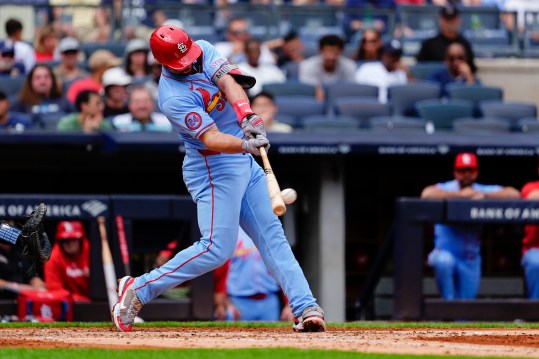
This past weekend the Yankees signed former NL MVP Paul Goldschmidt to a one-year $12.5 million contract, making him their primary first baseman for the 2025 season. Coming off of a career-worst season where he had a 100 wRC+ and hit 22 home runs, his declining OBP and strikeout numbers raise alarm bells regarding his short-term future in the league. It isn’t hard to see how he completely falls off in 2025, so why did the Yankees choose him as their solution to a position where they had a league-worst .619 OPS last year?
A player who will certainly test the Yankees’ evaluation and coaching skills, Paul Goldschmidt is an experiment that could yield surprisingly positive results with the right adjustments.
Can Paul Goldschmidt Turn The Clock Back With the Yankees?

Last season was not the year that Paul Goldschmidt and the St. Louis Cardinals were looking for, but the signs of a harsh regression were there in 2023. His wRC+ dropped from 175 to 122, one of the steepest regressions for a hitter after an MVP season, as his in-zone contact rates regressed and his game power took a sharp decrease. He went from a .578 SLG% to a .447 SLG% despite the league-wide SLG% climbing from .395 to .414 between 2022 and 2023, the highest mark we had seen since 2020.
The slide continued into 2024, with the power remaining stagnant but the strikeouts ballooning as Goldschmidt ran a 26.5% K% and a career-worst 7.2% walk rate. The reason for his slide in plate discipline and contact rates could be tied to his pull rates increasing, an indication that he began making earlier swing decisions. Swinging earlier can hurt a hitter’s ability to track the ball as it approaches the plate, causing a hitter to chase more often or miss the pitch entirely as they aren’t picking up the movement as well as they usually do.
Hitters rarely come back from that kind of decline; it’s hard to imagine that Goldschmidt’s going to get back his swing speeds from his peak years, and that gives me some concern regarding how he’ll perform in 2025. If he cannot improve his swing speeds, Goldschmidt will have to improve his plate discipline and contact rates, which seems extremely difficult to do in your age-37 season. I’ve been pretty pessimistic about his outlook for the upcoming season for those reasons, but perhaps there’s a way for the Yankees to get improvements in some of his plate skills at Yankee Stadium.
READ MORE: Yankees eyeing All-Star upside from injury-prone relief arm

This is Paul Goldschmidt’s spray chart against 95+ MPH pitches, and if you notice there’s not a ton of pulled contact in the air. What he does display is an excellent ability to smash the ball to right field, and in this sample size alone he would have added four more home runs to his total. With three flyouts and one double converting into four home runs, there are 14 total bases gained, which increases his SLG% from .398 to .522.
If Goldschmidt can incorporate more opposite-field flyballs in his game, he may not have to swing earlier and deal with the drawbacks in his walk rate and contact rate, but Busch Stadium has never been the ballpark for that kind of approach. Last season the veteran first baseman slugged an abysmal .378 at home with an 85 wRC+, but he would have had far more success if he played his home games in the friendlier dimensions of Yankee Stadium:
You can add six home runs to his total, removing five flyouts and a triple, bringing his SLG% from .378 to .450 based on that data. Granted, this doesn’t factor in what would have been a hit in St. Louis and what wouldn’t have been a hit in New York (and vice versa), but a lot of that comes from opposite-field power that just doesn’t get rewarded because the ballpark doesn’t play to it.
Attacking the right field porch would potentially give Paul Goldschmidt a mental cue to track the ball later to the plate, which would invite better swing decisions and perhaps cut down on the swing-and-miss. I have a pessimistic opinion on whether he can make that kind of adjustment with the Yankees, but Steamer’s optimistic projections for Paul Goldschmidt indicate that there are reasons to buy into the bat.

The Yankees have information that we don’t have access to, all do all 30 teams in Major League Baseball as biomechanical data is extremely useful for identifying swing mechanic deficiencies. I doubt that Brian Cashman and his baseball operations personnel are completely unaware of the plate discipline and contact regressions, and they likely have changes in mind they’d like to make to improve Paul Goldschmidt’s game.
Older hitters can get better; Brandon Belt signed a one-year deal with the Blue Jays and produced an OPS north of .800, Matt Carpenter was a negative WAR player in 2023 with awful contact rates before turning back the clock for one of the best 47-game stretches we have ever seen from a hitter in pinstripes. With Cody Bellinger and Ben Rice as backup options, the Yankees could even platoon with Paul Goldschmidt if it comes down to it.
First base isn’t a problem position for the Yankees right now; it’s not a reasonable expectation for Cody Bellinger, Paul Goldschmidt, and Ben Rice to all produce below-average value at the plate according to any projection system. The Yankees needed some thump in the lineup, and Paul Goldschmidt provides exactly that from the right-handed side, now the front office needs to take on the daunting task of finding a solid OBP threat at 2B or 3B to round out the roster.
